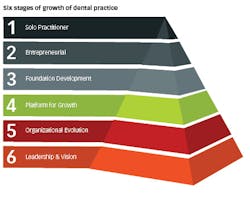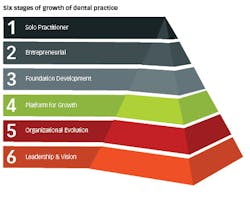Building your practice—Stage 1: solo practitioner
Editor's note: This article is part two of a seven-part series.
In last month’s article,I introduced the six stages of growth that map out the progression and key decisions necessary to evolve from a solo practice into a multilocation group practice, or dental service organization (DSO). As someone with 20-plus years of experience successfully growing DSOs, I identified all practices’ progress through the same six stages. If you aspire to become a growth-oriented expanding practice, the dental industry is ripe with opportunity. Developing your solid foundation for growth as explained in Stage 1 is your first step.
As you enter Stage 1, you’re likely working as an associate and being mentored by an established dentist-owner about the business and clinical aspects of the practice. In fact, after honing your clinical abilities and observing the day-to-day operations, you may think you can own your own practice. By the same token, you may be a current owner-doctor experiencing challenges with Stage 1 relative to niche, location, or office culture, preventing you from transitioning into Stage 2 (two to three offices).
In either case, the five components of Stage 1 are your blueprints for success—niche, location, buy or build, office name, and office culture. The decisions made in Stage 1 are all intertwined, and you will need to make choices in tandem. Once you accomplish Stage 1 and decide to take more steps toward entrepreneurial growth, my subsequent articles will continue to guide you through this process.
Niche
Niche is defined as a key segment of a market. The type of dentistry you want to practice—implantology, cosmetic, etc.—are examples of niche. So, what type of dentistry will you practice? This decision is often based on your interests, education, and experience, as well as the demographics of your market. Identifying your niche is key to determining where you will potentially practice. It is important to complete basic demographic research, including gathering census information and investigating the number of offices that exist in your location of interest by niche.
Location
Where will your office be located? Your niche is partly determined by your location and vice versa. You will need to complete similar market research to identify your target community. For example, if you’re interested in pursuing Medicaid, which often predominantly serves children in areas with low household median income, the demographics around the location must be in line with those needs. Many believe a high-profile location is paramount, but this is not always the case. While visibility and accessibility are valuable, a successful site is based on marrying your patients’ needs with location availability, market costs, and growth opportunities.
Buy or build
Associated with niche and location, the decision to buy an existing office or build one from scratch (a “de novo”) is usually a personally or financially driven choice. Again, there is no correct answer, and while it will affect your practice today, it will not necessarily impact subsequent offices. In either situation, appropriate bank financing is often necessary. Banks typically finance the purchase of an existing practice more readily (as opposed to a de novo) because an existing practice has an established patient base and cash flow.
Buy: In order to locate an existing office to purchase, you may reach out to dental office brokers, inquire with dental reps, network with colleagues, and review classified ads available through dental associations. When one office emerges as a forerunner, you can submit a letter of intent, which will allow you a predetermined number of days to complete the purchase and sale agreement, line up your financing, and complete due diligence (both clinical and operational). I recommend you use the services of a third party, such as a member of the Academy of Dental CPAs (a consultant who has experience in conducting due diligence on the operational aspect of the practice), for the financial portion of the due diligence. You should also conduct a chart audit to understand the clinical philosophy, opportunity, or concerns.
As part of the purchase and sale agreement, one way to ease the practice transition between doctors, team members, and patients is to have the seller continue to practice for a set period of time. More important is assuring that the hygiene team stays on board, since they have typically developed strong bonds and relationships with patients.
Build: If you choose de novo, you have the advantage of shaping everything to your specific needs, from location to office design, equipment, and team members. Consequently, you will need to build a patient base, which often involves marketing and signing on to participate with dental insurance plans. Once you identify the right location and space, connect with architects or your supplier’s design division and a contractor to determine costs for the build-out. Take these costs, along with the proposed lease terms and rate, to your accountant so he or she can build a budget that allows you to understand your fixed costs and breakeven point. You must be confident that you can surpass your breakeven point in order to begin your successful practice.
Spotlight: Practice management software
In Stage 1, you will be investing in dental hardware and software that will likely follow you long-term. If you’re thinking about growth, you need to be even more cognizant of how the practice management software you choose may support or potentially disrupt your goals.
Here are a few things to consider:
• How easy will it be for staff to learn the software? How much training will be required to fully use all of the features?
• Does it support centralized billing and accounting, insurance management, and collections?
• Can it provide your important metrics for a solo practice in a way that makes sense to you? What about metrics you will need for several offices?
• Can you customize reporting?
• Does it have a database that can eventually be shared by your other offices?
As with many of the decisions you make in Stage 1, your IT solutions, which determine the type of data you can track and what reports you can produce, will impact how the rest of your practice functions. Your tech choices are an important investment that should be based on your long-term goals and not just what’s cheapest or sufficient in the short-term.
Editor’s note:This spotlight is sponsored by Henry Schein’s Dentrix Enterprise.
Office name
Your office name can communicate your niche, specialty, location, or personal name. Keep in mind that it is often a good idea to choose a name that is applicable to a large audience (e.g., not too niche specific). The naming process can be as laborious as you make it; you can pay for advice from a marketing expert, or you can just go with your gut. Be sure no one else has the name locally, statewide, or in neighboring states because you want to ensure there is no brand conflict in the event of expansion. While you are mostly locked into the name for that office, when you expand, you are not obligated to apply that name to your new offices.
Office culture
Once you’ve defined your niche, determined your location, identified your practice name, launched your office, and established your team, it’s time to form an office culture. To have a positive office culture, you must define your mission, purpose, and values (MPVs), a fundamental way to engage and inspire your team and increase employee and patient retention and engagement. You can offer incentives to motivate your team to represent your values. It is important for MPVs to stay up-to-date so they can positively influence office culture and guide for growth. With practice ownership, you must clearly define your personal and professional goals for the coming years.
In my next article, I will review Stage 2: Entrepreneurial, and walk you through this crucial transition of moving from one office to two to three locations.
Vincent Cardillo, MBA, is an industry leader with more than 20 years of experience in leadership and partner roles in growing DSOs. Vincent’s latest ranking is No. 14 on the 2014 Inc. 500 list of fastest growing private companies, with growth of 12,896%. Vincent is the founder of Dental Management Innovations LLC (DMI), which provides outsourced C-suite services to dental groups and single offices that have the intention of growing. DMI positions its clients for long-term growth by strengthening their operational systems and infrastructure. Vincent also provides his expertise in operations, strategy, and financing to private equity firms and other financial institutions. His book on the six stages of growth will be published in late 2017. Contact him at [email protected].


